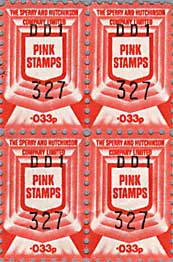Frequently Asked Pink Stamps Special or Lotus 30 and 40 Questions
Q: What are Pink Stamps?

A:Pink Stamps were trading coupons that rewarded consumers for grocery store and gas station loyalty with free appliances, furniture and other items. They are the British equivalent to the American Green Stamps, both owned by Sperry & Hutchinson Co. S&H Green Stamps were the dominant loyalty program of the 20th century.
On the right are a few samples of Pink Stamps. As you can see, they seem to be more red than pink in colour.
Q: Is that the original livery?
A: The Pink Stamps Special Lotus 30 originally raced under Team Willment colours during 1965-66 which was red with 3 white stripes over the top of the car. After Willment, the car raced for NIPEE Racing and they seem to have kept the Willment red colour scheme. It was in 1970 when the car was owned by Paul Gresham and driven by John Markey that the car was first painted in the pink colour that you see today. While we didn’t have a good colour chip to really go by, we used equal parts of red and a warm white paint to create our pink. Gresham and Markey kept the car in pink for 2 years and then changed it to an orange and white paint job. The remnants of those colors can be seen in our photos of when the car arrived in Portland in 1978.
Q: Are those real Gurney-Weslake heads on the Pink Stamps Special’s engine?
A: Yes.
Q: What is the engine displacement?
A: 5 Litres/302 cu in.
Q: What kind of gas mileage do you get?
A: We don’t know yet! It’s probably somewhere between 2 and 5 mpg.
Q: How long have you owned it?
A: Richard Keyes and John Strange bought the car in 1978. Currently, Richard Keyes is the sole owner.
Q: How many Lotus 30s and 40s were built?
A: There were 21 Series 1 Type 30s produced, 9 Series 2 Type 30s and 3 Lotus Type 40s. The Pink Stamps Special is the fifth car made of the Series 2 Type 30. This car has been identified as a ’30/40′ and as a ’40’ because it has been updated to the 40’s specifications. It appears that several of the other surviving Type 30s have been upgraded as well.
Q: Why is the Number ‘1’ backwards on the car?
A: Excellent question – We don’t know! The car raced several times with the reversed Number ‘1’. We just figured that when the number was originally cut out, the template was simply backwards and a right-reading number was not cut out to replace it. It’s also seems reasonable from looking at original photos of the car, that they were trying to maximize the size of the numbers in the roundel. By flipping the ‘1’, it gives you just a little more space for the other numbers.